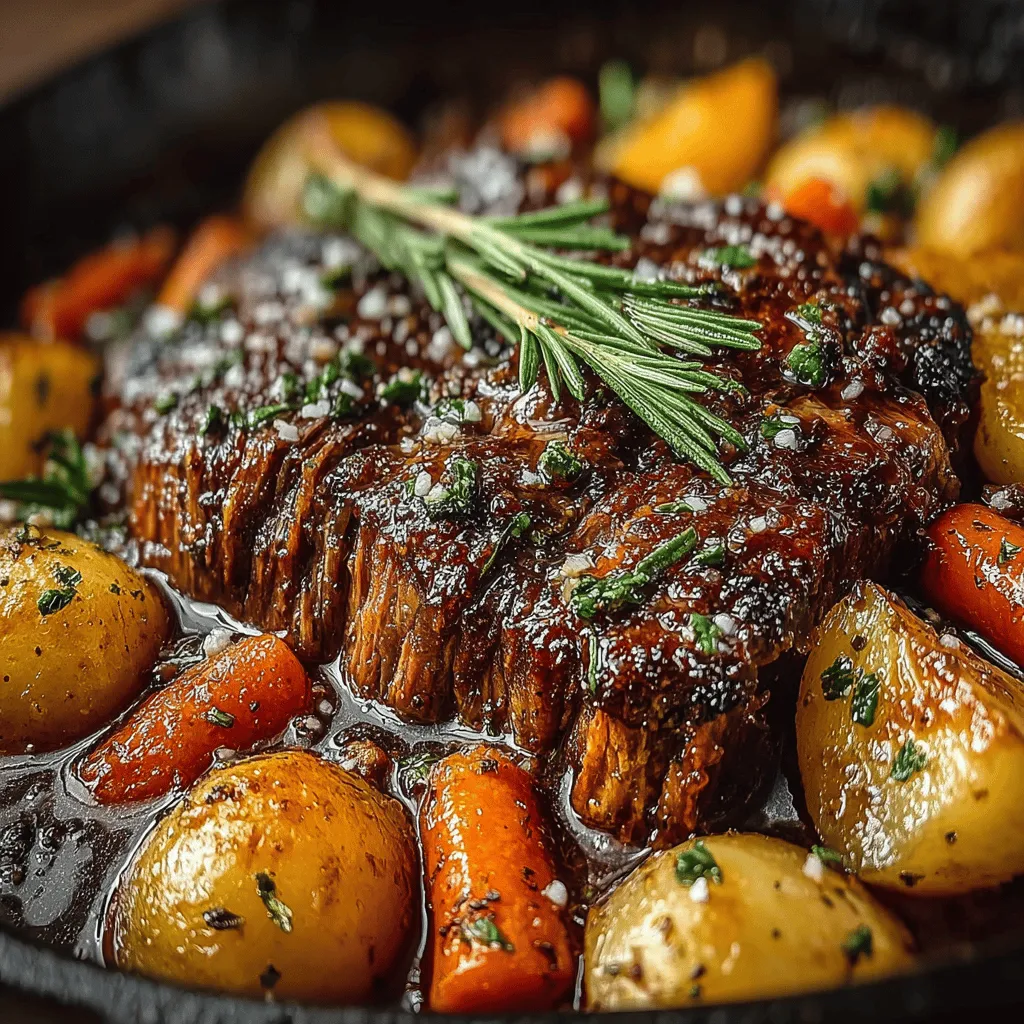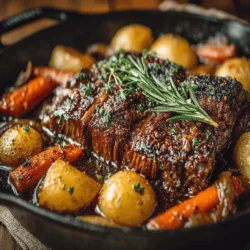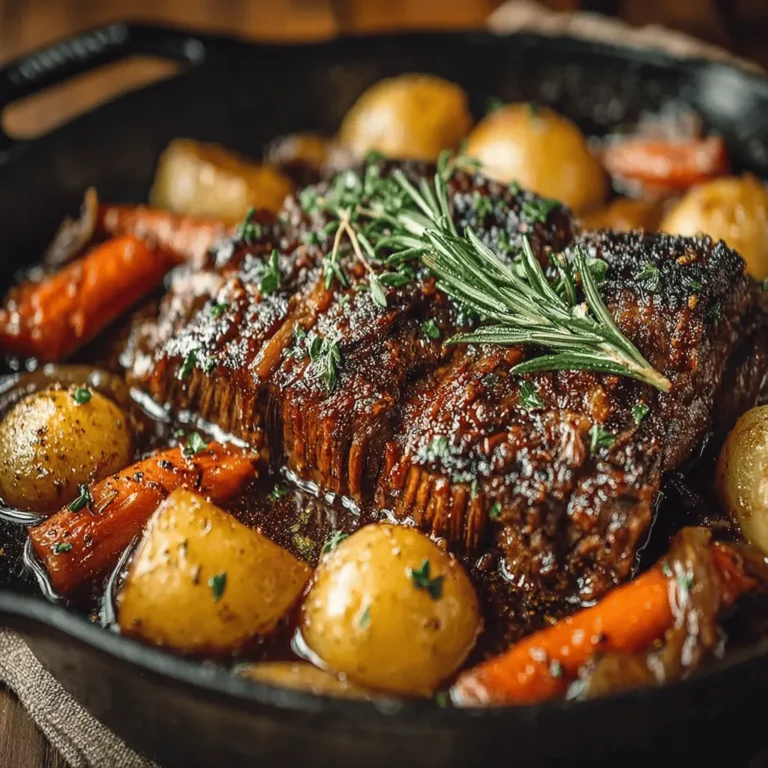Introduction to Savory Sunday Pot Roast
Embrace the warmth and comfort of a home-cooked meal with this Savory Sunday Pot Roast recipe. A quintessential dish that brings families together, pot roast is the perfect centerpiece for any Sunday dinner. This recipe is not just about cooking meat; it’s about creating a delightful experience filled with rich flavors and tender textures. With a blend of hearty vegetables and aromatic herbs, this pot roast is bound to become a favorite in your household.
The Allure of Pot Roast: A Culinary Tradition
Understanding Pot Roast
Pot roast has a cherished place in American cuisine, with roots that trace back to the early days of settlement. Originally, this dish emerged as a practical solution for using tougher cuts of meat, which were often the most affordable. Home cooks discovered that by slow-cooking these cuts, they could transform them into tender, succulent meals bursting with flavor. Over the years, pot roast has evolved into a beloved family classic, with countless variations that reflect regional tastes and seasonal ingredients. Today, it stands as a testament to the art of slow cooking, where time and care yield delicious results.
The essence of pot roast lies in its simplicity. It typically consists of a large cut of meat—often beef—that is braised slowly in a flavorful broth along with an array of vegetables. The slow cooking process allows the meat to become tender and allows the flavors of the ingredients to meld beautifully, creating a comforting dish that warms the soul.
Why Sunday is the Perfect Day for Pot Roast
Sunday dinners hold a special place in many households, representing a time to gather with loved ones after a busy week. The tradition of sharing a meal on Sundays often includes a hearty dish that can be prepared in advance, allowing families to relax and enjoy each other’s company. Pot roast is ideal for this occasion; it requires minimal active cooking time while the oven does the heavy lifting, providing a delicious meal meant for sharing.
As the aroma of a simmering pot roast fills the air, it creates a welcoming atmosphere, inviting everyone to the table. This dish not only satisfies hunger but also strengthens familial bonds, making it a perfect choice for a Sunday feast. Whether served with warm bread or paired with a crisp salad, a pot roast dinner creates lasting memories that families cherish for years.
Ingredients Breakdown
The Star of the Show: Boneless Chuck Roast
At the heart of this Savory Sunday Pot Roast is the boneless chuck roast, a cut known for its rich flavor and exceptional tenderness when cooked low and slow. Chuck roast comes from the shoulder area of the cow, which means it contains a good amount of connective tissue. When cooked over several hours, this tissue breaks down, resulting in a melt-in-your-mouth texture that is simply irresistible.
Choosing a high-quality chuck roast is essential for achieving the best results. Look for a cut that has marbling—those small flecks of fat running through the meat—which enhances flavor and juiciness. When selecting your roast, opt for one that feels firm to the touch and has a deep red color, indicating freshness.
Essential Aromatics: Onions and Garlic
No pot roast would be complete without the foundational flavors brought by aromatic vegetables. Onions and garlic are essential in this recipe, providing depth and complexity to the overall flavor profile. Onions caramelize beautifully during the cooking process, adding a natural sweetness that balances the savory elements of the dish. Garlic, on the other hand, infuses the meat and vegetables with a warm, aromatic essence that elevates the pot roast to new heights.
When preparing your ingredients, consider using yellow onions for their balanced sweetness or shallots for a milder flavor. Fresh garlic cloves will yield the best results, ensuring that each bite bursts with flavor.
The Supporting Cast: Vegetables
The vegetables in your pot roast not only enhance the dish’s flavor but also contribute to its heartiness. Common choices include carrots and potatoes, which provide a delightful contrast in textures and flavors. Carrots add a subtle sweetness, while potatoes offer a creamy, starchy element that pairs perfectly with the tender meat.
Feel free to get creative with your vegetable selection; celery, parsnips, or even turnips can be great additions, each bringing its unique flavor to the mix. The key is to choose vegetables that will hold up well during the long cooking time, ensuring they remain tender but not mushy.
Seasoning and Flavor Enhancers
To take your Savory Sunday Pot Roast to the next level, seasoning is crucial. Worcestershire sauce, tomato paste, and herbs like thyme and rosemary work together to create a well-rounded flavor profile that complements the meat and vegetables beautifully.
Worcestershire sauce adds a depth of umami flavor, enhancing the savory notes of the roast. Tomato paste contributes both richness and a hint of acidity, balancing the dish’s flavors. Fresh herbs such as thyme and rosemary not only add aromatic qualities but also brighten the overall taste, making each bite more vibrant.
Step-by-Step Cooking Instructions
Preparing the Roast
Before diving into the cooking process, it’s important to prepare your roast properly. Start by removing the boneless chuck roast from the refrigerator and allowing it to come to room temperature for about 30 minutes. This step is essential, as it promotes even cooking and helps the meat retain its juiciness.
Once the roast has reached room temperature, generously season all sides with salt and black pepper. Don’t skimp on the seasoning; this is your chance to enhance the meat’s natural flavors. You may also consider adding a sprinkle of garlic powder or onion powder for an extra layer of taste.
Searing the Meat to Perfection
Searing the roast is a crucial step that should not be overlooked. Begin by heating a large, heavy-bottomed pot or Dutch oven over medium-high heat. Add a tablespoon of oil—preferably vegetable or canola oil—to the pot and allow it to heat until shimmering.
Carefully place the seasoned roast into the hot pot, ensuring not to overcrowd it. Sear the meat on all sides until it develops a deep, golden-brown crust, which will take about 4-5 minutes per side. This caramelization not only adds a beautiful color but also enhances the flavor, creating a rich base for your pot roast. After achieving a perfect sear, remove the roast from the pot and set it aside on a plate while you prepare the aromatic vegetables and broth.
By following these initial steps, you’re well on your way to creating a Savory Sunday Pot Roast that will be the highlight of your family gathering. The combination of carefully selected ingredients and thoughtful preparation sets the stage for a delicious meal that embodies the essence of home cooking.

Cooking a pot roast is not just about throwing a hunk of meat into a pot and hoping for the best. It’s a culinary journey that combines technique, patience, and love, resulting in a dish that warms the heart and nourishes the soul. In this section, we’ll dive into the essential steps and techniques that ensure your Savory Sunday Pot Roast is not only delicious but also a memorable experience for you and your loved ones.
Searing: Locking in Juices and Flavor
The first step in creating a flavorful pot roast is searing the meat. This technique is crucial for locking in the juices and enhancing the overall flavor profile of the dish. When you sear the beef, you initiate the Maillard reaction, a chemical process that occurs when proteins and sugars in food are exposed to high heat. This reaction creates a beautiful brown crust on the meat, giving it a rich, savory flavor.
To achieve the perfect sear, follow these tips:
1. Preheat Your Pan: Use a heavy-bottomed skillet or Dutch oven and preheat it over medium-high heat. You want the pan hot enough that when you add the oil, it shimmers immediately.
2. Pat the Meat Dry: Before placing your roast in the pan, make sure to pat it dry with paper towels. Moisture on the surface will steam the meat instead of searing it.
3. Don’t Crowd the Pan: If your roast is large, consider cutting it into smaller pieces to ensure even cooking and browning. Overcrowding will lower the pan temperature, leading to steaming rather than searing.
4. Let It Be: Once the meat is in the pan, resist the urge to move it around. Allow it to develop a crust for about 4-5 minutes on each side before flipping.
Once the roast is beautifully browned on all sides, remove it from the pan and set it aside. This step lays the foundation for a mouth-watering pot roast.
Sautéing the Aromatics
Next, it’s time to build flavor through the addition of aromatics. Sautéing onions and garlic not only adds depth to your pot roast but also fills your kitchen with an irresistible fragrance.
To get that perfect softness and aroma from your aromatics, follow these instructions:
1. Choose the Right Fat: Use a combination of olive oil and butter for sautéing. The oil has a high smoke point, while the butter adds a rich flavor.
2. Chop Uniformly: Dice your onions and mince your garlic uniformly to ensure even cooking.
3. Cook the Onions First: Start by adding the onions to the pan over medium heat. Cook them for about 5-7 minutes until they are translucent and slightly caramelized. This brings out their natural sweetness.
4. Add Garlic Last: Stir in the minced garlic and cook for an additional 1-2 minutes. Garlic cooks much faster than onions and can burn easily, so you want to add it toward the end of the sautéing process.
The result will be a fragrant base that enhances the flavor of your pot roast significantly.
Deglazing: Unlocking Flavor
After sautéing your aromatics, the next step is deglazing the pan. This involves adding liquid to the hot pan to scrape up any browned bits stuck to the bottom, known as fond. This step is essential for maximizing flavor in your pot roast.
Here’s how to deglaze properly:
1. Choose Your Liquid: You can use beef broth, red wine, or even water for deglazing. If you opt for wine, choose a dry variety, as it will complement the meat’s flavor.
2. Add the Liquid: Pour your chosen liquid into the pan while it’s still hot. The liquid will bubble and steam, loosening the fond from the bottom of the pan.
3. Scrape the Bottom: Using a wooden spoon or spatula, gently scrape the bottom of the pan to lift the browned bits. This action releases concentrated flavors that enrich your stew.
4. Let It Reduce: Allow the liquid to simmer for a few minutes until it reduces slightly. This intensifies the flavor before adding the rest of the ingredients back into the pot.
Once deglazing is complete, return your seared roast to the pot, along with any additional ingredients.
Combining Ingredients for a Flavorful Stew
Now it’s time to bring everything together. The key to a successful pot roast is ensuring all ingredients are combined harmoniously and are submerged in liquid for even cooking.
1. Add Vegetables: Place your root vegetables—like carrots, potatoes, and celery—around the roast. These will absorb the flavors of the broth and contribute to the overall dish.
2. Pour in the Broth: Add enough beef broth to cover the roast and vegetables completely. This ensures even cooking and allows the flavors to meld beautifully over time.
3. Season Generously: Don’t forget to season your broth with salt, pepper, and herbs like thyme or rosemary. This is your opportunity to infuse the dish with flavor.
4. Bring to a Simmer: Before covering, bring the mixture to a light simmer. This helps the flavors start to meld before the long cooking process.
The Art of Slow Cooking
The magic of a pot roast truly happens during the slow cooking process. Whether you choose to cook it on the stovetop or in the oven, patience is key.
1. Cover the Pot: Once your ingredients are combined and simmering, cover the pot tightly. This traps moisture, creating a steamy environment that keeps the roast tender.
2. Cooking Time: If cooking on the stovetop, reduce the heat to low and let it simmer for 3-4 hours. For oven cooking, preheat your oven to 325°F (163°C) and cook for about 3 hours, or until the meat is fork-tender.
3. Check for Doneness: The best indicator of doneness is the meat’s tenderness. It should pull apart easily with a fork. If it’s not quite there yet, give it additional time.
Achieving the Perfect Seasoning
Before serving your pot roast, it’s crucial to taste and adjust the seasoning of the broth. This step elevates the dish and ensures every bite is bursting with flavor.
1. Conduct a Taste Test: Use a spoon to sample the broth. You want to balance the flavors of salt, acidity, and richness.
2. Adjust as Needed: If the broth is too salty, add a splash of vinegar or a bit of sugar to balance the flavors. If it’s lacking seasoning, sprinkle in some salt or herbs.
3. Optional Additions: For a pop of color and texture, consider adding frozen peas in the last 10 minutes of cooking. They will brighten the dish and add a pleasant sweetness.
Presentation and Serving Suggestions
Now that your pot roast is ready, it’s time to present it beautifully for your family or guests. A well-plated dish not only looks appetizing but also enhances the dining experience.
Plating the Pot Roast
1. Slice with Care: Use a sharp knife to slice the roast against the grain. This will ensure tender pieces that are easier to chew.
2. Arrange Thoughtfully: Place slices of roast on a large serving platter or individual plates. Surround them with the sautéed vegetables and generous spoonfuls of the broth.
3. Garnish: For a finishing touch, sprinkle fresh herbs like parsley or thyme over the top. This adds a burst of color and freshness.
Pairing Suggestions
To complete your meal, consider serving your pot roast with complementary side dishes and beverages:
– Side Dishes: Creamy mashed potatoes, buttered corn, or a crisp green salad make excellent accompaniments. They balance the richness of the roast.
– Beverages: Pair your pot roast with a full-bodied red wine, such as Cabernet Sauvignon or Merlot, which will enhance the flavors of the meat.
Conclusion: The Comfort of Savory Sunday Pot Roast
There is something undeniably comforting about a home-cooked pot roast. It’s a dish that not only satisfies hunger but also fosters connections and creates lasting memories around the dinner table. The Savory Sunday Pot Roast is a celebration of simplicity and rich flavors, making it perfect for family gatherings or a cozy Sunday dinner.
As you gather with your loved ones, share stories and laughter over this hearty meal. The effort and care you put into preparing this dish will not go unnoticed, as each bite reveals the love and warmth of home cooking. So, as you indulge in this savory delight, remember that it’s more than just a meal; it’s a cherished moment shared with those you hold dear. Enjoy your Savory Sunday Pot Roast, and let it become a cherished part of your culinary repertoire for years to come.


